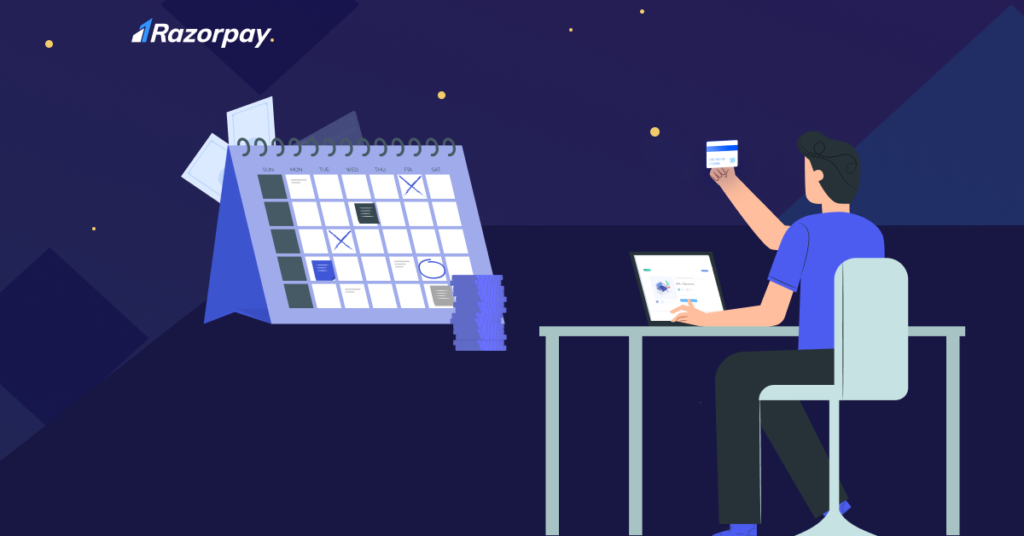Today’s online-first consumer is living the ultimate dream – an ever-increasing number of choices and an ever-depleting attention span. As for businesses that wish to survive (and thrive) in this era of aggressive digitisation, offering convenience and flexibility is the only way to go.
The subscription-based model has slowly risen to become the holy grail among businesses who want to win over customers for the long haul by providing convenience at their fingertips.
Up until a few years ago, subscriptions were predominantly limited to the media and entertainment industry. However, today, subscription businesses are just as prevalent in eCommerce, edtech, SaaS, and many more budding verticals.
In fact, the top 5 sectors that made up 74% of all Razorpay subscription transactions in the last 6 months were the following:
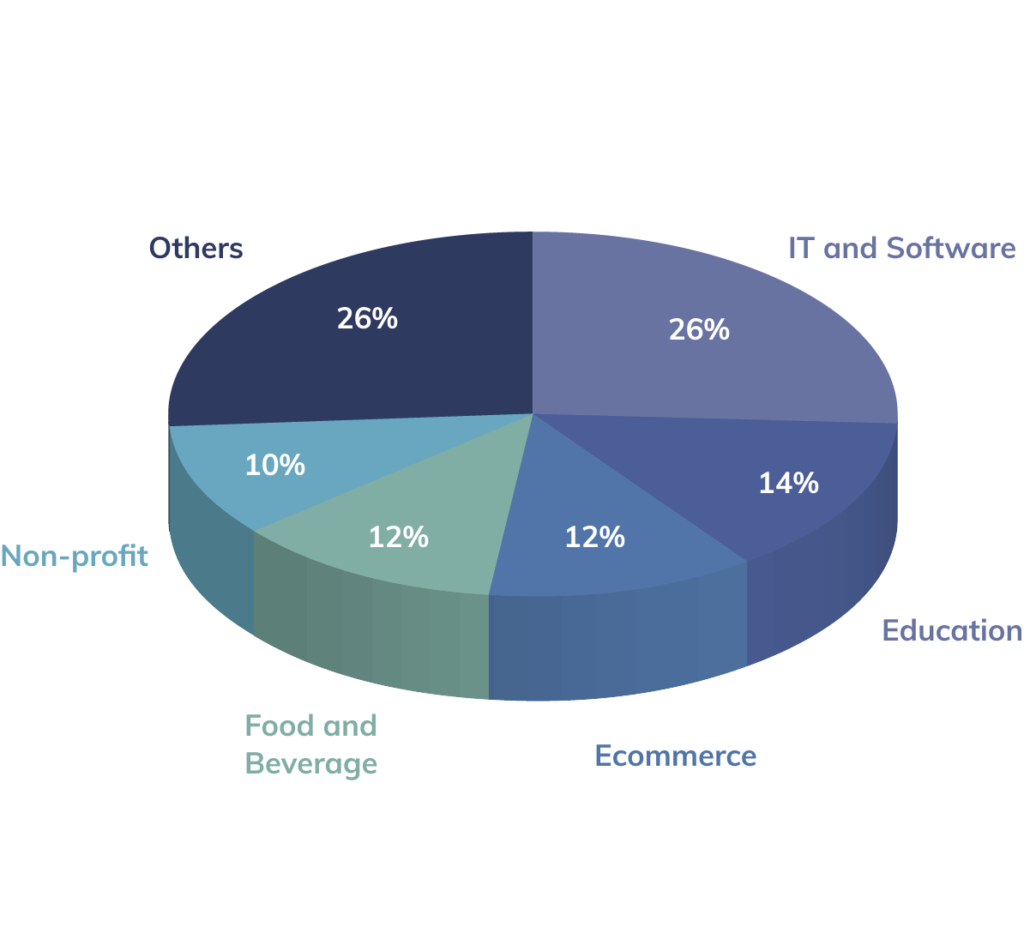
However, offering a subscription product or service and collecting recurring payments isn’t as straightforward as it sounds. There are multiple unprecedented roadblocks or simply layers of complexities that subscription businesses need to be prepared for to provide a memorable experience and a hassle-free journey to their customers.
Let’s dissect some of those challenges and how subscription businesses can work their way around them.
Offering multiple subscription billing models
Since subscription plans are all about flexibility and catering to each and every customer’s unique needs, there is no one size fits all pricing model that you can opt for. Based on the nature of your business, there are multiple categories of billing models you need to consider so you can offer abundant choice and freedom to your customers.
Freemium
- A subscription plan that allows customers to get started for free and pay when/if they wish to upgrade
- For example, a customer opts for a software tool that allows them to use it for free for the first 30 days, post which they will be billed
The SaaS behemoth, Zoho offers its customers a 30-day free trial before they have to pick a plan and start paying:
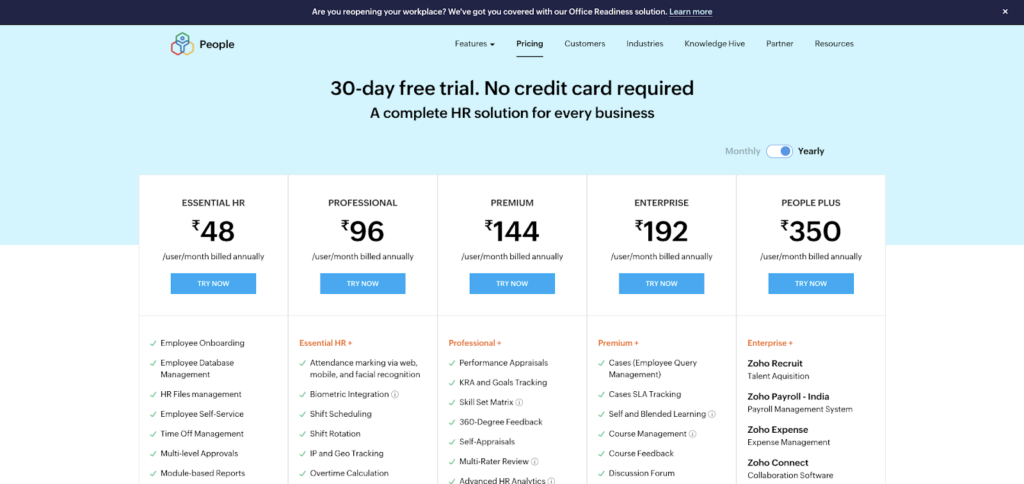
Fixed schedule and pricing
- Customers are charged a fixed amount at a fixed interval for a pre-decided quantity of product(s)
- For example, a customer opts for prescribed medicine to be delivered to them at the beginning of each month. Both the frequency and bill amount are fixed. Or, a non-profit organisation could offer fixed support plans for donors.
Here’s an example of the fixed monthly and yearly support plans offered by The Wire – an independent, non-profit journalist organisation:
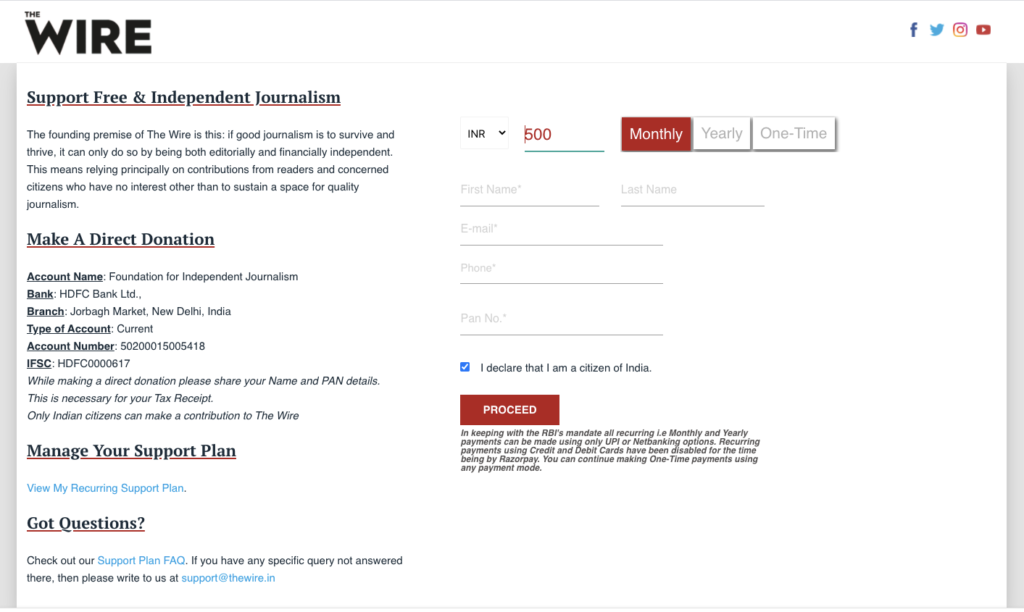
Fixed schedule and pricing + add-ons
- Customers are billed at a pre-decided frequency. However, the billing amount varies depending on the additional goods/services opted for
- For example, a customer subscribes to a hair care product to be delivered at the beginning of each month. But, this month, they change the quality required to 2 instead of 1 bottle, thus changing the billing amount
Amazon makes it extremely easy to opt for such a subscription plan:
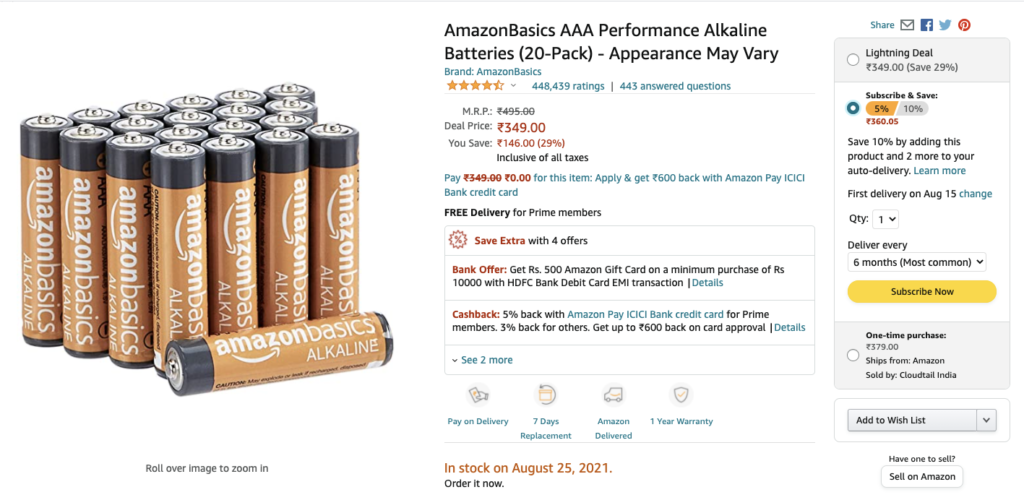
Tiered/pay-per-unit pricing
- Customers are charged based on the volume or quantity purchased as per the pre-defined tiers
- For example, a SaaS company could create tiers based on the number of users that sign up for the tool from a single account. 10-20 users ($10 each), 20-50 users ($8 each), 50+ users ($5 each)
- Similarly, eCommerce subscription businesses can also use this pricing model based on pre-decided brackets of product usage
Here’s an example from RO renting company, Livpure Smart:

Usage-based pricing
- Customers are charged for exactly what they use. No fixed billing amount, no tiers, no initial commitments
- For example, cell phone subscription plans wherein users pay for the number of minutes consumed or texts sent, etc.
The pay as you go pricing model that Twilio offers is an excellent example:
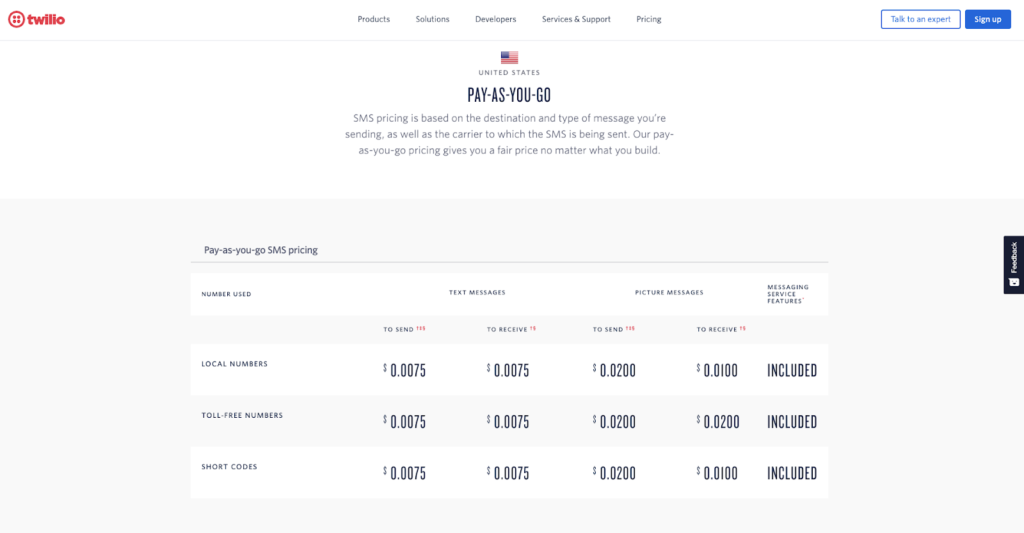
The model you opt for will directly impact your revenue, so make sure you finalise the one best suited for your target audience, business requirements, and category.
Offering flexibility and real-time modifications to subscription plans
Even after putting a whole lot of thought into selecting the right subscription plan, your customers might want to upgrade, downgrade, cancel, or change their plan a few days into their billing cycle. For example, soon after opting for a basic plan of an edtech platform, a student realises that the courses offered are quite helpful and hence decides to upgrade their plan to include mock tests and live exams. Now, they must be provided with the flexibility to upgrade their plan without having to wait for the next billing date. Otherwise, you not only end up with a frustrated customer but also leave money on the table.
Moreover, if you also need to think about issuing refunds in case a customer downgrades their plan in the middle of their billing cycle. Customers are going to be impatient at this point, and you cannot keep them waiting or expect them to understand complicated messaging or navigate complex user flows.
Real-time modifications to subscription plans are something you need to be prepared for by allowing customers to make adjustments to their ongoing plans as and when they wish to and having provision for prorated invoicing. All such changes need to be properly accounted for, communicated to the customer, and cause no hindrance to the overall user experience.
Providing a seamless end-to-end customer experience
Subscriptions offer convenience, but can also lead to poor customer experience if your:
- Communication lacks clarity
- Cancellations are not seamless
- Timely notifications aren’t sent out
- Billing details are not provided with transparency, and so on.
Due to ever-increasing competition between subscription businesses, you can only stay ahead of the curve if you ensure that your customer experience is delightful and absolutely seamless. You don’t want to leave your customers in doubt, have them reach out to support over and over again to pause a subscription, not be reminded of their upcoming payment, or have no proper control and visibility into their subscription plans.
The bottom line is that you must choose a subscriptions tool that manages the entire backend so smoothly that the customer journey on your platform is always commendable.
Offering the right payment modes
Cards, UPI, Net banking, International cards – there’s a whole range of payment methods that you need to consider and evaluate (based on your audience demographics) to zero in on the ones you need to offer to your subscription customers. Only then can you choose a subscription tool for your business depending upon whether it offers the payment methods you need.
For example, if your target audience is based majorly out of tier 2 and tier 3 cities, you would want to consider UPI payments, since it is the most popular payment method in those parts of the country. On the other hand, if you own a SaaS business and your customers are based out of different parts of the world, you would need to have international cards as a payment option on your subscription plans.
Sending out timely reminders and managing missed payments
Once signed up for a subscription plan, your customers are more than likely to forget about it. Therefore, you need to ensure you are sending out timely payment reminders to customers well before their payment deadline, so they don’t miss out. They would also need to ensure that their linked bank account/card has enough funds for the payment well in advance. Even then, you can expect certain failed or missed transactions that you would need to track and manage.
Allowing customers to pause and resume their plans
Your customers might change their minds after opting for a plan or would want to put it on hold when not in use. You need to have a provision for pausing and resuming a subscription plan so that they don’t end up cancelling it in case the product or service is not required for some time. This would also allow you to reduce churn and increase your customer lifetime value.
Providing enhancements or add-ons
If at any point while using your product or services, if a customer wants to add enhancements to their existing plan, they should be able to do so without having to completely upgrade to a different one. You need to have the provision to modify the quantity of a certain product so that the customer can continue the same subscription plan instead of cancelling it and signing up for a new one.
For example, if a customer subscribes to a jar of coffee from your eCommerce store to be delivered to them in the second week of every month, you should have the provision to allow them to opt for 2 jars in a particular month instead of one without having to sign up for a whole new plan.
Offering enticing discounts and promotions
Very often, you might want to make subscription plans available to your customers as a means of offering a discount on bulk or recurring purchases. However, there are tonnes of questions you need to ask yourself before creating and running an offer. Which or how many billing cycles would the offer run for? Will it be a limited time offer or an always-on one? Which cohort of customers will it be applicable for? Will it be a flat discount or a percentage of the billing amount? Will it be applicable on a specific payment mode or all of them? Once you have clarity on each of these parameters, you can create offers for your subscription plans and leverage them to increase your sign up and retention figures.
Take a look at how women wellness brand, Nua Woman offers discounts on their subscription plans:
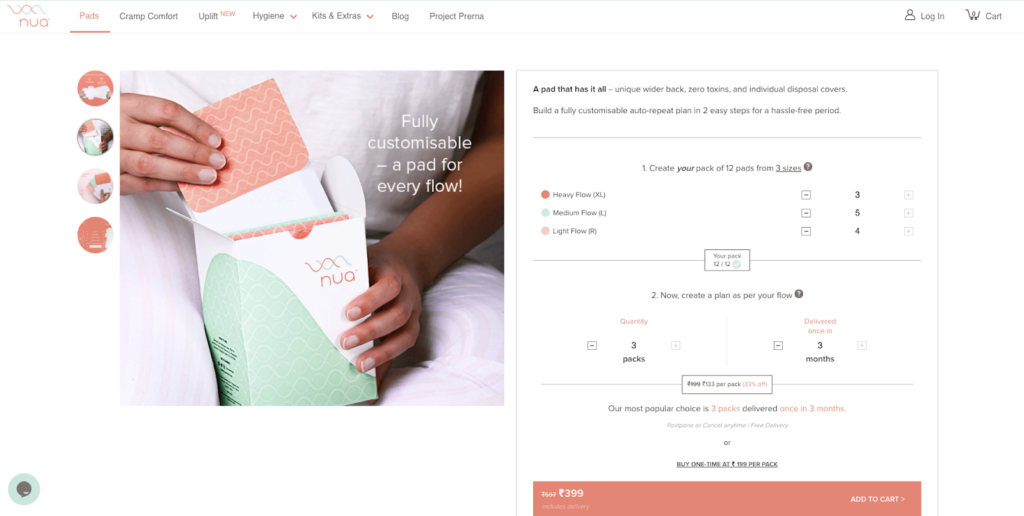
Generating automatic invoices
With great flexibility, comes great complexity! As subscriptions allow you to offer numerous customisation options, enhancements or add-ons, convenience to pause and resume a plan, choose payment frequencies and even upgrade or downgrade in the middle of a billing cycle, managing invoicing can be a challenge if you are just starting out.
Manual billing is completely out of the question as it is impossible to keep track and stay on top of so much data. You need to automate your billing system so that no invoices are generated and sent out to customers based on their chosen plan, usage, or tier on their respective due dates.
Overcoming challenges and riding the subscriptions wave
Sure, there are some added nuances to running subscription businesses and managing recurring payments. However, in the larger scheme of things, the benefits that subscriptions bring to the table are absolutely incomparable and game-changing, both for end consumers and businesses.
To make it big as a subscription business, think of the challenges we discussed above as merely tiny bumps in the road that you need to navigate through or a few checklist items that you need to ensure are in place. As long as you focus on optimising your user experience and improving your customer happiness and customer satisfaction, you are sure to give your competitors a run for their money.
If you are confused about picking the right subscriptions tool, you needn’t look any further. Razorpay Subscriptions is a robust tool that provides you with the complete flexibility of offering a delightful experience to your end customers. Whether it is pausing and resuming their plans as per their requirements, upgrading and downgrading plans, choosing from a range of payment methods, or opting for enhancements, your customers can do it all and more seamlessly.
Razorpay Subscriptions is designed to tackle all challenges discussed above and many more that might arise so you can direct all your efforts towards growing and scaling your business.
